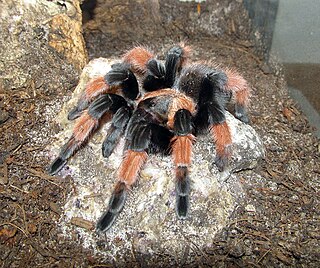
A tarantula hawk is a spider wasp (Pompilidae) that preys on tarantulas. Tarantula hawks belong to any of the many species in the genera Pepsis and Hemipepsis. They are one of the largest parasitoid wasps, using their sting to paralyze their prey before dragging it to a brood nest as living food; a single egg is laid on the prey, hatching to a larva which eats the still-living prey.

Wasps in the family Pompilidae are commonly called spider wasps, spider-hunting wasps, or pompilid wasps. The family is cosmopolitan, with some 5,000 species in six subfamilies. Nearly all species are solitary, and most capture and paralyze prey, though members of the subfamily Ceropalinae are kleptoparasites of other pompilids, or ectoparasitoids of living spiders.

The Goliath birdeater belongs to the tarantula family Theraphosidae. Found in northern South America, it is the largest spider in the world by mass – 175 g (6.2 oz) – and body length – up to 13 cm (5.1 in) – but it is second to the giant huntsman spider by leg span. It is also called the Goliath bird-eating spider; the practice of calling theraphosids "bird-eating" derives from an early 18th-century copper engraving by Maria Sibylla Merian that shows one eating a hummingbird. Despite the spider's name, it only rarely preys on birds.

Brachypelma is a genus of spiders in the family Theraphosidae (tarantulas). They may have bodies up to 6 cm long with legs of similar or greater lengths. Some species have brightly colored legs, with red or orange marks and rings.
Cyriopagopus hainanus is a species of spider in the family Theraphosidae (tarantulas), found in China. It is one of a number of species from China and Vietnam known as "Chinese bird spider". It produces a venom containing numerous compounds capable of blocking neurotransmitters, including neurotoxic peptides called hainantoxins.

Cyriopagopus schmidti is a species of spider in the family Theraphosidae (tarantulas), found in China and Vietnam. It is one of a number of species known as "Chinese bird spider" and "Chinese earth tiger". Haplopelma huwenum was synonymized with this species in 2008. Spiders under this name and its synonyms have been shown to produce toxins called huwentoxins.

Lycoris is a genus of 13–20 species of flowering plants in the family Amaryllidaceae, subfamily Amaryllidoideae. They are native to eastern and southern Asia in China, Japan, southern Korea, northern Vietnam, northern Laos, northern Thailand, northern Burma, Nepal, northern Pakistan, Afghanistan, and eastern Iran. They were imported into North Carolina and now grow wild. In English they are also called hurricane lilies or cluster amaryllis. The genus shares the English name spider lily with two other related genera.

Poecilotheria metallica, also known as the Gooty sapphire ornamental, is an Old World species of tarantula. It is the only blue species of the genus Poecilotheria. Like others in its genus it exhibits an intricate fractal-like pattern on the abdomen. The species' natural habitat is deciduous forest in Andhra Pradesh, in central southern India. It has been classified as Critically endangered by the IUCN.
Stromatoxin is a spider toxin that blocks certain delayed-rectifier and A-type voltage-gated potassium channels.

Tarantulas comprise a group of large and often ″hairy″ spiders of the family Theraphosidae. Currently, about 1,000 species have been identified. The term tarantula is usually used to describe members of the family Theraphosidae, although many other members of the same infraorder (Mygalomorphae) are commonly referred to as "tarantulas" or "false tarantulas". Some of the more common species have become popular in the exotic pet trade. Many New World species kept as pets have urticating hairs that can cause irritation to the skin, and in extreme cases, cause damage to the eyes.
Jingzhaotoxin proteins are part of a venom secreted by Chilobrachys jingzhao, the Chinese tarantula. and act as neurotoxins. There are several subtypes of jingzhaotoxin, which differ in terms of channel selectivity and modification characteristics. All subspecies act as gating modifiers of sodium channels and/or, to a lesser extent, potassium channels.

Cyriopagopus is a genus of southeast Asian tarantulas found from Myanmar to the Philippines. As of March 2017, the genus includes species formerly placed in Haplopelma. It was first described by Eugène Louis Simon in 1887.

Aphonopelma iodius is a species of spider in the tarantula family Theraphosidae, found in United States. A 1997 paper combined it with three other previously described species into a single species, calling it "A. iodium". However, iodius is a neuter comparative adjective and is the correct form. Aphonopelma smithii has also been synonymized with A. iodius. A. iodius is common in the Mojave Desert to the west of the Colorado River. As of 1997, the distribution of A. iodius farther south or west into the Mojave Desert or North into Nevada and Utah was undetermined.

Chilobrachys is a genus of Asian tarantulas that was first described by Ferdinand Anton Franz Karsch in 1892.

Phlogiellus is a genus of tarantulas that was first described by Reginald Innes Pocock in 1897.
Plesiophrictus is a genus of tarantulas that was first described by Reginald Innes Pocock in 1899.

Chilobrachys dyscolus is a species of tarantulas found in Vietnam.
Chilobrachys andersoni, commonly known as the Burmese mustard tarantula, or Burmese Brown, is a species of spider of the genus Chilobrachys. It is found in India, Myanmar, Thailand and Malaysia.
Chilobrachys jonitriantisvansicklei is a species of tarantula of the genus Chilobrachys. It is endemic to Sri Lanka. The species is named for Joni Triantis Van Sickle, a conservationist involved in protecting the area. It is characterized by iridescent blue markings on its legs.












